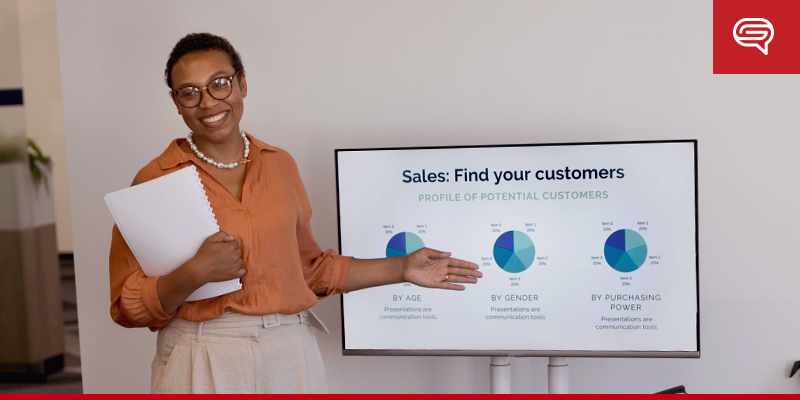Capturing and maintaining the audience’s attention is critical when delivering information through presentations. Moreover, presenters must ensure their message is easily understood and retained. Visual hierarchy plays a significant role in achieving these goals.
Visual hierarchy helps guide the audience’s focus and comprehension. It allows presenters to emphasize key points, create a sense of order, and enhance the overall visual appeal of their slides.
Need a Presentation Designed?
Click Here To View Our Amazing Portfolio
In this blog, we will explore the concept of visual hierarchy and discuss practical tips and best practices for applying a visual hierarchy to captivate your audience.
What is Visual Hierarchy?
Visual hierarchy refers to the arrangement and organization of elements within a design or layout to guide the viewer’s attention and convey the intended message.
It involves strategically using elements such as size, color, contrast, alignment, and typography to establish a clear order of importance and create visual impact.
Applying Visual Hierarchy in Presentations
Let’s dive into the practical steps you can take to implement visual hierarchy in your presentations.
Planning and structuring the content
Careful planning and content structuring are crucial when applying visual hierarchy in presentations.
- Identify key points and hierarchy levels. Determine the main ideas and supporting details in your presentation. Establish a clear hierarchy of information based on its importance.
- Group-related information. Organize similar concepts or content into logical groups. This helps the audience understand the relationships between different elements and facilitates information retention.
- Create a logical flow. Arrange the content coherently and sequentially. Ensure that each slide and section of your presentation follows a logical progression, making it easy for the audience to follow your train of thought.
Using size and scale effectively
Size and scale are powerful tools for establishing a visual hierarchy within your slides.
- Make important elements stand out. Use larger sizes and bolder styles for headlines, key points, or visually impactful elements. This draws attention and emphasizes their significance.
- Establish visual hierarchy within slides. Vary the sizes of text and visual elements to create a clear distinction between main ideas, supporting details, and less important information. This guides the audience’s focus and helps them navigate through the content.
Leveraging color and contrast
Color and contrast can greatly enhance the visual impact of your presentation.
- Use color to emphasize and differentiate. Select a color palette that complements your branding or topic. Use vibrant or contrasting colors to highlight important information or create visual groupings. This draws attention and adds visual interest.
- Ensure readability and accessibility. Consider the contrast between text and background colors to ensure legibility, especially for people with visual impairments. Opt for high-contrast combinations and avoid color combinations that strain the eyes or hinder readability.
Aligning and positioning elements strategically
Proper alignment and positioning contribute to your presentation’s overall visual appeal and organization.
- Establish visual alignment and balance. Align elements consistently on each slide to create a sense of order and professionalism. Use vertical and horizontal alignment to create a clean and polished look.
- Use grids and guides. Utilize the grid and guide features provided by presentation software to ensure consistent alignment and spacing between elements. This helps maintain a visually pleasing and harmonious layout.
Utilizing typography and font styles
Typography plays a crucial role in visual hierarchy.
- Choose appropriate fonts for readability. Select legible fonts, even in smaller sizes. Sans-serif fonts are often a safe choice for presentations, but make sure the font style aligns with your overall branding and topic.
- Emphasize key information with font variations. Use font variations such as bold, italic, or different font weights to highlight vital elements. However, avoid excessive font variations that may distract or confuse the audience. Maintain consistency in font choices throughout your presentation.

Best Practices for Creating Visual Hierarchy in Presentations
Let’s delve into these best practices and discover how they can enhance the effectiveness of your presentations.
Keep the visual hierarchy simple and clean
When it comes to visual hierarchy in presentations, simplicity is key.
Avoid overcrowding your slides with excessive information or complex visuals that can overwhelm your audience. Keep your design clean and uncluttered, allowing the main elements to stand out and grab attention. Moreover, embrace white space and use it strategically to enhance your slides’ overall visual appeal and legibility.
Maintain consistency in design and layout
Consistency is crucial for a cohesive and professional-looking presentation.
Ensure that your design elements, such as color schemes, fonts, and alignment, remain consistent throughout your slides. This creates a unified visual identity and makes navigation and comprehension easier for the audience. Consistency also reinforces your branding and message, leaving a lasting impression on your audience.
Use visual cues strategically
Visual cues can be powerful tools for guiding the audience’s attention and emphasizing key points.
Utilize graphical elements like arrows, bullet points, or icons strategically to direct the viewer’s focus and highlight important information. However, use these visual cues sparingly and purposefully to avoid overwhelming or distracting your audience.
Remember, simplicity and clarity should always be the guiding principles.
Consider the audience and context
Understanding your audience is essential for creating an effective visual hierarchy in presentations.
Consider their preferences, expectations, and cultural sensitivities when making design choices. Tailor your visuals and content to resonate with your specific audience and the context of your presentation.
By doing so, you can create a more personalized and engaging experience that speaks directly to your viewers.
Test and refine the visual hierarchy
Like any design process, testing and refinement are crucial for creating an effective visual hierarchy.
Seek feedback from colleagues, friends, or trusted individuals to evaluate the clarity and impact of your presentation design. Make adjustments based on their input to improve the visual hierarchy and ensure your message is conveyed effectively. Testing and refining your presentation will ultimately result in a polished and engaging final product.
Need a Presentation Designed?
Click Here To View Our Amazing Portfolio
Understanding and implementing visual hierarchy is crucial for creating impactful presentations. The next time you prepare a presentation, remember to harness the power of visual hierarchy to create a compelling and engaging experience for your audience.





















